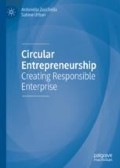Abstract
The transition of existing businesses towards the circular economy does not operate according to a unique kind of process: variety is correlated to numerous specific features. That makes the “real economy” interesting to discover while promising efficient, effective solution models. The first section is dedicated to large multinational companies, SUEZ and Saint-Gobain, forerunners in the circular economy, but following different evolutionary paths. SUEZ promotes a radical “resource revolution”; Saint-Gobain, founded in 1665, is opting for a continuous evolutionary innovation process. The second section focuses on two successful family-owned businesses: the Hager Group and Soprema, with different business cultural backgrounds. The third section looks at organizational problems for very large firms (like Engie) and small and agile ones (like EIM).
Access this chapter
Tax calculation will be finalised at checkout
Purchases are for personal use only
References
Brafman, Ori, and Rod A. Beckstrom. 2007. The Starfish and the Spider; The Unstoppable Power of Leaderless Organizations. New York: Penguin Group.
Conner, Clifford D. 2005. A People’s History of Science: Miners, Midwives, and Low Mechanicks. New York: Nation Books.
Miller, Danny, and I. Le Breton-Miller. 2004. Managing for the Long Run; Lessons in Competitive Advantage from Great Family Businesses. Boston, MA: Harvard Business School Press.
MIT (Meadows, Donella et al.). 1972. The Limits to Growth. Boston, MA: Universe Books, Potomac Association.
Poole, Marshall Scott, and Andrew H. Van de Ven. 2004. Handbook of Organizational Change and Innovation. Oxford: Oxford University Press.
Stern, Nicholas. 2010. A Blueprint for a Safer Planet. How We Can Save the World and Create Prosperity. London: Vintage Books.
Author information
Authors and Affiliations
Rights and permissions
Copyright information
© 2019 The Author(s)
About this chapter
Cite this chapter
Urban, S. (2019). The Transition of Existing Businesses Towards the Circular Economy: Circular Corporate Entrepreneurship. In: Circular Entrepreneurship. Palgrave Macmillan, Cham. https://doi.org/10.1007/978-3-030-18999-0_5
Download citation
DOI: https://doi.org/10.1007/978-3-030-18999-0_5
Published:
Publisher Name: Palgrave Macmillan, Cham
Print ISBN: 978-3-030-18998-3
Online ISBN: 978-3-030-18999-0
eBook Packages: Business and ManagementBusiness and Management (R0)

